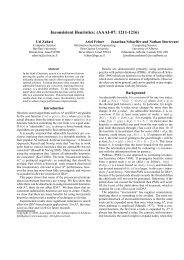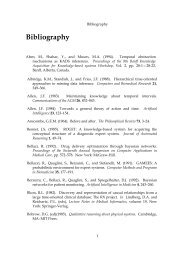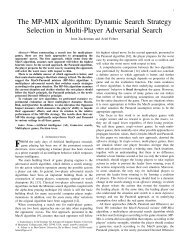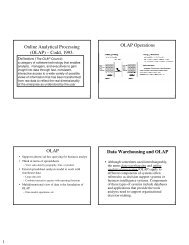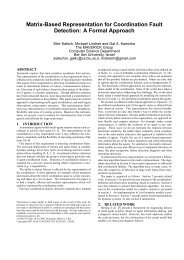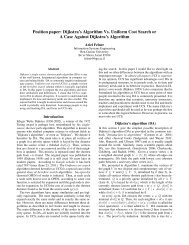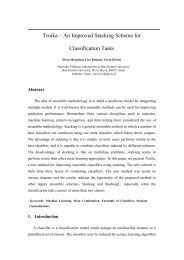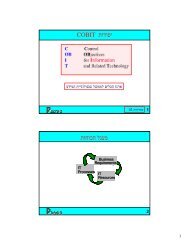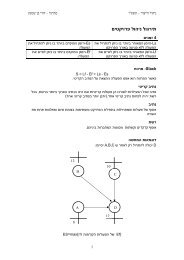BnB-ADOPT: An Asynchronous Branch-and-Bound DCOP Algorithmâ
BnB-ADOPT: An Asynchronous Branch-and-Bound DCOP Algorithmâ
BnB-ADOPT: An Asynchronous Branch-and-Bound DCOP Algorithmâ
You also want an ePaper? Increase the reach of your titles
YUMPU automatically turns print PDFs into web optimized ePapers that Google loves.
<strong>BnB</strong>-<strong>ADOPT</strong>:<br />
<strong>An</strong> <strong>Asynchronous</strong> <strong>Branch</strong>-<strong>and</strong>-<strong>Bound</strong> <strong>DCOP</strong> Algorithm ∗<br />
William Yeoh<br />
Computer Science<br />
University of Southern<br />
California<br />
Los <strong>An</strong>geles, CA 90089, USA<br />
wyeoh@usc.edu<br />
Ariel Felner<br />
Information Systems<br />
Engineering<br />
Ben-Gurion University<br />
Beer-Sheva, 85104, Israel<br />
felner@bgu.ac.il<br />
Sven Koenig<br />
Computer Science<br />
University of Southern<br />
California<br />
Los <strong>An</strong>geles, CA 90089, USA<br />
skoenig@usc.edu<br />
ABSTRACT<br />
Distributed constraint optimization (<strong>DCOP</strong>) problems are a<br />
popular way of formulating <strong>and</strong> solving agent-coordination<br />
problems. It is often desirable to solve <strong>DCOP</strong> problems<br />
optimally with memory-bounded <strong>and</strong> asynchronous algorithms.<br />
We introduce <strong>Branch</strong>-<strong>and</strong>-<strong>Bound</strong> <strong>ADOPT</strong> (<strong>BnB</strong>-<br />
<strong>ADOPT</strong>), a memory-bounded asynchronous <strong>DCOP</strong> algorithm<br />
that uses the message passing <strong>and</strong> communication<br />
framework of <strong>ADOPT</strong>, a well known memory-bounded asynchronous<br />
<strong>DCOP</strong> algorithm, but changes the search strategy<br />
of <strong>ADOPT</strong> from best-first search to depth-first branch-<strong>and</strong>bound<br />
search. Our experimental results show that <strong>BnB</strong>-<br />
<strong>ADOPT</strong> is up to one order of magnitude faster than <strong>ADOPT</strong><br />
on a variety of large <strong>DCOP</strong> problems <strong>and</strong> faster than NCBB,<br />
a memory-bounded synchronous <strong>DCOP</strong> algorithm, on most<br />
of these <strong>DCOP</strong> problems.<br />
Categories <strong>and</strong> Subject Descriptors<br />
I.2.11 [Artificial Intelligence]: Distributed Artificial Intelligence;<br />
I.2.8 [Artificial Intelligence]: Problem Solving,<br />
Control Methods, <strong>and</strong> Search<br />
General Terms<br />
Algorithms<br />
Keywords<br />
Agent cooperation::distributed problem solving<br />
1. INTRODUCTION<br />
Distributed constraint optimization (<strong>DCOP</strong>) problems are<br />
a popular way of formulating <strong>and</strong> solving agent-coordination<br />
∗ This research was done while Ariel Felner spent his sabbatical at<br />
the University of Southern California, visiting Sven Koenig. This<br />
research has been partly supported by an NSF award to Sven<br />
Koenig under contract IIS-0350584. The views <strong>and</strong> conclusions<br />
contained in this document are those of the authors <strong>and</strong> should<br />
not be interpreted as representing the official policies, either expressed<br />
or implied of the sponsoring organizations, agencies, companies<br />
or the U.S. government.<br />
Cite as: <strong>BnB</strong>-<strong>ADOPT</strong>: <strong>An</strong> <strong>Asynchronous</strong> <strong>Branch</strong>-<strong>and</strong>-<strong>Bound</strong> <strong>DCOP</strong><br />
Algorithm, W. Yeoh, A. Felner, S. Koenig, Proc. of 7th Int. Conf.<br />
on Autonomous Agents <strong>and</strong> Multiagent Systems (AAMAS<br />
2008), Padgham, Parkes, Müller <strong>and</strong> Parsons (eds.), May, 12-16., 2008,<br />
Estoril, Portugal, pp. XXX-XXX.<br />
Copyright c○ 2008, International Foundation for Autonomous Agents <strong>and</strong><br />
Multiagent Systems (www.ifaamas.org). All rights reserved.<br />
problems, including scheduling meetings [8], coordinating<br />
unmanned aerial vehicles [14] <strong>and</strong> allocating targets to sensors<br />
[1]. A <strong>DCOP</strong> problem consists of several agents that<br />
need to take on values so that the sum of the resulting<br />
constraint costs is minimal. Each agent often has only a<br />
fixed amount of memory available. This calls for memorybounded<br />
<strong>DCOP</strong> algorithms. The agents have to communicate<br />
with each other, but communication is often restricted<br />
to nearby agents. This calls for <strong>DCOP</strong> algorithms that<br />
restrict communication to agents that share constraints.<br />
<strong>DCOP</strong>s can be solved quickly if the agents can act independently<br />
without having to wait for other agents. This<br />
calls for asynchronous <strong>DCOP</strong> algorithms. <strong>ADOPT</strong> is a popular<br />
<strong>DCOP</strong> algorithm that satisfies these three constraints<br />
<strong>and</strong> uses best-first search to solve <strong>DCOP</strong> problems optimally<br />
[12]. In this paper, we develop another <strong>DCOP</strong> algorithm<br />
that satisfies the three constraints <strong>and</strong> solves <strong>DCOP</strong> problems<br />
optimally but is faster than <strong>ADOPT</strong> on many <strong>DCOP</strong><br />
problems.<br />
<strong>DCOP</strong> problems are combinatorial search problems with<br />
depth-bounded search trees. It is known that such search<br />
problems can often be solved faster with memory-bounded<br />
depth-first branch-<strong>and</strong>-bound search than with memorybounded<br />
best-first search since memory-bounded best-first<br />
search needs to repeatedly reconstruct partial solutions that<br />
it purged from memory [16]. Consequently, depth-first<br />
branch-<strong>and</strong>-bound search has been extended to distributed<br />
constraint satisfaction problems [6, 2] <strong>and</strong> even to <strong>DCOP</strong><br />
problems. However, the existing depth-first branch-<strong>and</strong>bound<br />
<strong>DCOP</strong> algorithms are either synchronous (NCBB [3]<br />
<strong>and</strong> SBB [6]) or broadcast messages <strong>and</strong> thus do not restrict<br />
communication to agents that share constraints (AFB<br />
[4]). We therefore introduce <strong>Branch</strong>-<strong>and</strong>-<strong>Bound</strong> <strong>ADOPT</strong><br />
(<strong>BnB</strong>-<strong>ADOPT</strong>), a memory-bounded asynchronous <strong>DCOP</strong><br />
algorithm that uses the message passing <strong>and</strong> communication<br />
framework of <strong>ADOPT</strong> to restrict communication to agents<br />
that share constraints. Our experimental results show that<br />
<strong>BnB</strong>-<strong>ADOPT</strong> is up to one order of magnitude faster than<br />
<strong>ADOPT</strong> on a variety of large <strong>DCOP</strong> problems, namely for<br />
coloring graphs, scheduling meetings <strong>and</strong> allocating targets<br />
to sensors. It is also faster than NCBB on most of these<br />
<strong>DCOP</strong> problems.<br />
2. <strong>DCOP</strong> PROBLEMS<br />
A <strong>DCOP</strong> problem consists of a finite set of agents with<br />
independent computing power <strong>and</strong> a finite set of constraints.<br />
Each agent takes on (= assigns itself) a value from its finite
domain. Each constraint involves two agents <strong>and</strong> specifies<br />
its non-negative constraint cost as a function of the values<br />
of these two agents. A solution is an agent-value assignment<br />
for all agents, while a partial solution is an agent-value assignment<br />
for a subset of agents. The cost of a solution is the<br />
sum of the constraint costs of all constraints. Solving the<br />
<strong>DCOP</strong> problem optimally means to determine the cost of<br />
a cost-minimal solution. Each agent needs to decide which<br />
value to take on based on its knowledge of the constraints<br />
that it is involved in <strong>and</strong> messages that it can exchange with<br />
the other agents. These messages can be delayed by a finite<br />
amount of time but are never lost.<br />
3. <strong>BnB</strong>-<strong>ADOPT</strong><br />
x i x j Cost<br />
0 0 5<br />
0 1 8<br />
1 0 20<br />
1 1 3<br />
for i < j<br />
(a) (b) (c)<br />
Figure 1: Example <strong>DCOP</strong> Problem<br />
<strong>DCOP</strong> problems can be represented with constraint<br />
graphs, whose vertices are the variables <strong>and</strong> whose edges<br />
are the constraints. Figure 1(a) shows the constraint graph<br />
of an example <strong>DCOP</strong> problem with three agents that can<br />
each take on the values zero or one. There is a constraint<br />
between each pair of agents. Figure 1(c) shows the constraint<br />
costs of the example <strong>DCOP</strong> problem, which are the<br />
same for all three constraints. Constraint trees are spanning<br />
trees of constraint graphs with the property that edges of the<br />
constraint graphs can connect vertices only with their ancestors<br />
or descendants in the constraint trees. Sibling subtrees<br />
represent disjoint subproblems of the <strong>DCOP</strong> problem. Figure<br />
1(b) shows one possible constraint tree of the example<br />
<strong>DCOP</strong> problem, where the dotted line is part of the constraint<br />
graph but not the constraint tree. This constraint<br />
tree is actually a constraint chain <strong>and</strong> thus there are no disjoint<br />
subproblems. The operation of <strong>DCOP</strong> algorithms on<br />
constraint trees can be visualized with search trees. Figure 2<br />
shows a search tree for this constraint tree, where levels 1, 2<br />
<strong>and</strong> 3 of the search tree correspond to agents x 1, x 2 <strong>and</strong> x 3,<br />
respectively. Left branches correspond to the agents taking<br />
on the value zero <strong>and</strong> right branches to the agents taking on<br />
the value one. Each non-leaf node thus corresponds to a partial<br />
solution of the <strong>DCOP</strong> problem <strong>and</strong> each leaf node to a<br />
solution. Figure 2(a) shows the identifiers of the nodes that<br />
allow us to refer to them easily, <strong>and</strong> Figure 2(b) shows the<br />
sums of the constraint costs of all constraints that involve<br />
only agents with known values. These sums correspond to<br />
the f-values of an A* search [5] since we assume for simplicity<br />
of illustration that all heuristics are zero for our example<br />
<strong>DCOP</strong> problem. For example, node f corresponds to agent<br />
x 1 taking on value one, agent x 2 taking on value zero <strong>and</strong><br />
agent x 3 having an unknown value. Thus, the sum of the<br />
constraint costs of all constraints that involve only agents<br />
with known values is 20, namely the cost of the constraint<br />
that involves agents x 1 <strong>and</strong> x 2.<br />
<strong>ADOPT</strong> [12] is a best-first search algorithm. Best-first<br />
x 1<br />
x 2<br />
d<br />
b<br />
e<br />
x 3 h i j k l m n o<br />
a<br />
(a)<br />
f<br />
c<br />
g<br />
x 1<br />
x 2<br />
5<br />
0<br />
8<br />
x 3 15 21 33 19 45 31 43 9<br />
0<br />
(b)<br />
Figure 2: Search Tree<br />
search exp<strong>and</strong>s nodes in the search tree for the first time in<br />
order of increasing f-values until it finds a solution. For our<br />
example <strong>DCOP</strong> problem, best-first search exp<strong>and</strong>s nodes in<br />
the search tree for the first time in the order a, b, c, g,<br />
d, e, <strong>and</strong> o. <strong>ADOPT</strong> is basically a distributed version of<br />
RFBS [7]. In order to be memory-bounded, it maintains<br />
only a branch from the root node to the currently exp<strong>and</strong>ed<br />
node <strong>and</strong> thus needs to repeatedly reconstruct nodes that it<br />
purged from memory. For example, it has the branch from<br />
a to e in memory when it exp<strong>and</strong>s node e but then needs to<br />
have the branch from a to o in memory when it exp<strong>and</strong>s node<br />
o. Thus, it needs to reconstruct the part of this branch from<br />
a to g. Depth-first branch-<strong>and</strong>-bound search, on the other<br />
h<strong>and</strong>, exp<strong>and</strong>s the children of a node in order of increasing f-<br />
values <strong>and</strong> prunes those nodes whose f-values are no smaller<br />
than the smallest f-value of any leaf node that it has already<br />
observed. It backtracks once all children of a node have<br />
been exp<strong>and</strong>ed or pruned. For our example <strong>DCOP</strong> problem,<br />
depth-first branch-<strong>and</strong>-bound search exp<strong>and</strong>s nodes in<br />
the search tree in the order a, b, d, h, (i), e, (k), (j), c,<br />
g, <strong>and</strong> o, where it prunes the nodes in parentheses. It is<br />
memory-bounded without having to repeatedly reconstruct<br />
nodes that it purged from memory but exp<strong>and</strong>s some nodes<br />
that a best-first search does not exp<strong>and</strong>, such as node h.<br />
Centralized depth-first branch-<strong>and</strong>-bound search algorithms<br />
often run faster than centralized best-first search algorithms.<br />
They can be used to solve <strong>DCOP</strong> problems but typically order<br />
the agents completely. Distributed depth-first branch<strong>and</strong>-bound<br />
search algorithms might be able to solve <strong>DCOP</strong><br />
problems faster by operating on disjoint subproblems concurrently,<br />
as demonstrated by AOBB [10]. One can convert<br />
centralized depth-first branch-<strong>and</strong>-bound search algorithms<br />
relatively easily into synchronous distributed <strong>DCOP</strong> algorithms.<br />
<strong>Asynchronous</strong> distributed <strong>DCOP</strong> algorithms might<br />
be able to solve <strong>DCOP</strong> problems faster by not having to<br />
synchronize the agents tightly.<br />
We therefore develop <strong>BnB</strong>-<strong>ADOPT</strong>, a novel asynchronous<br />
distributed <strong>DCOP</strong> algorithm that performs depth-first<br />
branch-<strong>and</strong>-bound search, by using the existing architecture<br />
<strong>and</strong> communication framework of <strong>ADOPT</strong>, resulting<br />
in an asynchronous distributed version of AOBB [10]. However,<br />
we do not describe <strong>BnB</strong>-<strong>ADOPT</strong> as an extension of<br />
<strong>ADOPT</strong> since this requires the readers to have an in-depth<br />
underst<strong>and</strong>ing of <strong>ADOPT</strong>. Instead, we give a st<strong>and</strong>-alone<br />
description of <strong>BnB</strong>-<strong>ADOPT</strong> that requires no knowledge of<br />
<strong>ADOPT</strong>, with the intention to create a self-contained <strong>and</strong><br />
hopefully easy-to-read overview. In the following, we introduce<br />
the notation that we need for describing <strong>BnB</strong>-<strong>ADOPT</strong><br />
<strong>and</strong> describe some of its key variables, including how they<br />
are updated. We describe a simplified depth-first search version<br />
of <strong>BnB</strong>-<strong>ADOPT</strong>, which we then enhance by performing<br />
branch-<strong>and</strong>-bound <strong>and</strong> increasing concurrency. We show the<br />
pseudocode of <strong>BnB</strong>-<strong>ADOPT</strong>, outline its correctness proof<br />
<strong>and</strong> finally describe our experimental results.<br />
20<br />
0<br />
3
3.1 Notation<br />
We use the following notation from <strong>ADOPT</strong> to describe<br />
<strong>BnB</strong>-<strong>ADOPT</strong>: V is the finite set of agents of the<br />
<strong>DCOP</strong> problem. Dom(a) is the domain of agent a ∈ V .<br />
V alInit(a) ∈ Dom(a) is the value that we use as initial<br />
value of agent a ∈ V . C(a) ⊆ V is the set of children of<br />
agent a in the constraint tree <strong>and</strong> CD(a) ⊆ V is the set of<br />
its descendants (including its children) that it is involved in<br />
constraints with. pa(a) ⊆ V is the parent of agent a ∈ V ,<br />
A(a) ⊆ V is the set of its ancestors (including its parent),<br />
SCA(a) ⊆ A(a) is the set of its ancestors (including its<br />
parent) that it or one of its descendants is involved in constraints<br />
with <strong>and</strong> CA(a) ⊆ SCA(a) is the set of its ancestors<br />
(including its parent) that it is involved in constraints with.<br />
3.2 Key Variables<br />
Consider any agent a ∈ V . Assume that the values of all<br />
ancestors a ′ ∈ A(a) are given by the partial solution X a (a<br />
set of agent-value assignments), called the context of agent<br />
a. δX a a(d) is the sum of the constraint costs of all constraints<br />
that involve both agent a <strong>and</strong> one of its ancestors, under the<br />
assumption that agent a takes on value d <strong>and</strong> its ancestors<br />
take on their respective values in X a . γX a a(d) is the sum of<br />
the constraint costs of all constraints that involve agent a<br />
<strong>and</strong>/or one of its descendants, 1 minimized over the possible<br />
values of its descendants, under the assumption that agent<br />
a takes on value d <strong>and</strong> its ancestors take on the values in<br />
X a . 2 We use the relationships<br />
γX a a := min<br />
d ′ ∈Dom(a) {γa X a(d′ )}<br />
γX a a(d) := δa X a(d) + ∑<br />
γX a′<br />
a ∪(a,d)<br />
a ′ ∈C(a)<br />
for all agents a ∈ V , all values d ∈ Dom(a) <strong>and</strong> all contexts<br />
X a of agent a. Solving the <strong>DCOP</strong> problem optimally means<br />
to determine γX r r for the root agent r in the constraint tree<br />
since γX r r is the sum of the constraint costs of all constraints,<br />
minimized over the possible values of all agents. 3<br />
Imagine that every agent a ∈ V stores <strong>and</strong> updates several<br />
lower <strong>and</strong> upper bounds, namely lb a,a′<br />
X a (d), LBa X a(d), LBa X a,<br />
ub a,a′<br />
X a (d), UBa X a(d) <strong>and</strong> UBa Xa for all values d ∈ Dom(a),<br />
all contexts X a of agent a, <strong>and</strong> all children a ′ ∈ C(a), maintaining<br />
the “<strong>Bound</strong> Property”:<br />
lb a,a′<br />
X a (d) ≤ γ a′<br />
X a ∪(a,d)<br />
≤ ub a,a′<br />
X a (d)<br />
LB a X a(d) ≤ γa X a(d) ≤ UBa X a(d)<br />
LB a X a ≤ γa X a ≤ UBa X a.<br />
It initializes lb a,a′<br />
Xa (d) := ha,a′<br />
Xa (d) for admissible heuristics<br />
0 ≤ h a,a′<br />
Xa (d) ≤ γa′ X a ∪(a,d) <strong>and</strong> ub a,a′<br />
Xa (d) := ∞ for all values<br />
1 Thus, the constraints involve either both agent a <strong>and</strong> one of<br />
its ancestors, both agent a <strong>and</strong> one of its descendants, both a<br />
descendant <strong>and</strong> an ancestor of agent a, or two descendants of<br />
agent a.<br />
2 In other words, γX a a(d) is the smallest increase in the sum of the<br />
constraint costs of all constraints that involve only agents with<br />
known values when one augments the partial solution X a ∪(a, d)<br />
with agent-value assignments for all descendants of agent a.<br />
3 X r is always {}.<br />
d ∈ Dom(a), all contexts X a of agent a, <strong>and</strong> all children a ′ ∈<br />
C(a). It then uses repeatedly the “Update Equations”:<br />
lb a,a′<br />
X a (d) := max{lb a,a′<br />
X a (d), LBX a′<br />
a ∪(a,d) }<br />
LBX a a(d) := δa X a(d) + ∑<br />
lb a,a′<br />
X a (d)<br />
a ′ ∈C(a)<br />
LBX a a := min<br />
d ′ ∈Dom(a) {LBa X a(d′ )}<br />
ub a,a′<br />
X a (d) := min{ub a,a′<br />
X a (d), UBX a′<br />
a ∪(a,d) }<br />
UBX a a(d) := δa X a(d) + ∑<br />
ub a,a′<br />
X a (d)<br />
a ′ ∈C(a)<br />
UBX a a := min<br />
d ′ ∈Dom(a) {UBa X a(d′ )}<br />
for all values d ∈ Dom(a), all contexts X a of agent a <strong>and</strong> all<br />
children a ′ ∈ C(a), which improve the bounds monotonically<br />
(that is, decrease the upper bounds <strong>and</strong> increase the lower<br />
bounds) while maintaining the <strong>Bound</strong> Property. 4 After a<br />
finite amount of time, LBX a a = UBa Xa for all agents a ∈<br />
V , all values d ∈ Dom(a) <strong>and</strong> all contexts X a of agent<br />
a. Then, LBX r r = γr X r = UBr Xr, which means that the<br />
<strong>DCOP</strong> problem is solved optimally. Termination is achieved<br />
by sending TERMINATE messages from parents to children<br />
down the constraint tree.<br />
3.3 Simplified Version of <strong>BnB</strong>-<strong>ADOPT</strong><br />
In actuality, every agent a ∈ V stores lb a,a′<br />
X a (d), LBa X a(d),<br />
LBX a a, uba,a′<br />
X a (d), UBa X a(d) <strong>and</strong> UBa X a for all values d ∈<br />
Dom(a) <strong>and</strong> all children a ′ ∈ C(a) but only one context<br />
X a of agent a at a time because it would not be memorybounded<br />
otherwise. Thus, it can work on only one context<br />
at a time. This context is stored in the variable X a , which<br />
makes it unnecessary to index the other variables with X a<br />
(although we continue to do so). <strong>BnB</strong>-<strong>ADOPT</strong> uses depthfirst<br />
search as its search strategy, which ensures that every<br />
agent needs to work on <strong>and</strong> thus store only one context<br />
at a time. We now give a simplistic description of<br />
how an agent operates. Consider any agent a ∈ V with<br />
context X a <strong>and</strong> value d a ∈ Dom(a). The agent sends<br />
so-called VALUE messages to all children a ′ ∈ C(a) with<br />
the context X a ∪ (a, d a ). The children return so-called<br />
COST messages with LB a′<br />
X a ∪(a,d a ) <strong>and</strong> UB a′<br />
X a ∪(a,d a ). The<br />
agent then uses the Update Equations to improve lb a,a′<br />
X a (da ),<br />
LBX a a(da ), LBX a a, uba,a′<br />
X a (da ), UBX a a(da ), <strong>and</strong> UBX a a <strong>and</strong><br />
sends LBX a a <strong>and</strong> UBa Xa to its parent in a COST message.<br />
If LBX a a(da ) < UBX a a(da ), then the agent repeats the process.<br />
After a finite amount of time, LBX a a(da ) = UBX a a(da ),<br />
which means that LBX a a(da ) <strong>and</strong> UBX a a(da ) cannot be improved<br />
further. The agent then takes on the new value<br />
d a := arg min d∈Dom(a) {LBX a a(d)} <strong>and</strong> repeats the process<br />
until either its context X a changes (because the agent receives<br />
a VALUE message from its parent with a different<br />
context) or LBX a a(d) = UBa Xa(d) for all values d ∈ Dom(a)<br />
<strong>and</strong> thus LBX a a = UBa Xa after a finite amount of time. Every<br />
agent a ∈ V takes on every value d ∈ Dom(a) at most<br />
4 Leaf agents in the constraint tree use the same Update Equations.<br />
Since they do not have children, the sums over their children<br />
evaluate to zero. For example, LBX a a(d) = UBa X a(d) =<br />
δX a a(d) for all leaf agents a ∈ V , all values d ∈ Dom(a) <strong>and</strong> all<br />
contexts X a of agent a.
once until its context X a changes or LBX a a = UBa Xa. <strong>BnB</strong>-<br />
<strong>ADOPT</strong> thus performs depth-first search.<br />
3.4 Performing <strong>Branch</strong>-<strong>and</strong>-<strong>Bound</strong><br />
The description so far of how an agent operates is simplistic.<br />
We now describe how an agent uses branch-<strong>and</strong>-bound<br />
search to reduce the runtime. (A more detailed explanation<br />
is given in [15].) Every agent a ∈ V maintains a threshold<br />
TH a X a, initialized to infinity (Line 17).5 The threshold is<br />
used for pruning during the depth-first search, resulting in<br />
the agent not taking on some values. Every agent a ∈ V with<br />
value d a ∈ Dom(a) <strong>and</strong> context X a operates as described<br />
before until its context changes, with two differences: First,<br />
it uses min{TH a X a, UBa X a} instead of the larger UBa X a(da )<br />
in the condition that determines whether it should take on a<br />
new value, resulting in the agent not taking on some values.<br />
Consequently, if LBX a a(da ) ≥ min{THX a a, UBa Xa}, then it<br />
takes on the new value d a := arg min d∈Dom(a) {LBX a a(d)}<br />
(Lines 23, 24). Second, when agent a ∈ V sends a VALUE<br />
message to its child a ′ ∈ C(a), it now includes not only the<br />
desired context X a ∪ (a, d a ) but also the desired threshold<br />
min{THX a a, UBa X a} − δa X a(da ) − ∑ a ′′ ∈C(a),a ′′ ≠a<br />
lb a,a′′<br />
′ X a (da )<br />
for the child (Line 29). This desired threshold is chosen such<br />
that LBX a a(da ) for the agent reaches min{THX a a, UBa X a}<br />
<strong>and</strong> the agent thus takes on a new value when LB a′<br />
X a ∪(a,d a )<br />
for the child reaches the desired threshold.<br />
The context of the agent changes when its parent sends it<br />
a VALUE message with a context X a different from its context.<br />
The agent then changes its context to X a , changes its<br />
threshold to the threshold in the VALUE message, initializes<br />
lb a,a′<br />
X<br />
a (d) := ha,a′<br />
Xa (d) <strong>and</strong> uba,a′<br />
Xa (d) := ∞ <strong>and</strong> uses the Update<br />
Equations to initialize LBX a a(d), UBa X a(d), LBa X a <strong>and</strong><br />
UBX a a for all values d ∈ Dom(a) <strong>and</strong> all children a′ ∈ C(a),<br />
takes on the new value d a := arg min d∈Dom(a) {LBX a a(d)}<br />
<strong>and</strong> repeats the process.<br />
3.5 Increasing Concurrency<br />
The description so far of how an agent operates is still<br />
simplistic since <strong>BnB</strong>-<strong>ADOPT</strong> does not synchronize agents<br />
tightly. <strong>BnB</strong>-<strong>ADOPT</strong> uses the following techniques to increase<br />
concurrency:<br />
First, the agents use reduced contexts, that are subsets of<br />
the contexts described so far. Consider an agent a ∈ V with<br />
context X 1 that contains the agent-value assignments for all<br />
ancestors a ′ ∈ A(a). Then, γ a X 1<br />
= γ a X 2<br />
where X 2 ⊆ X 1<br />
is the subset of agent-value assignments for all ancestors<br />
a ′ ∈ SCA(a) that it or one of its descendants is involved<br />
in constraints with. Thus, in the implemented version of<br />
<strong>BnB</strong>-<strong>ADOPT</strong>, the agents use these reduced contexts.<br />
Second, the agents propagate contexts differently than described<br />
so far. In the implemented version of <strong>BnB</strong>-<strong>ADOPT</strong>,<br />
an agent sends VALUE messages to all descendants that<br />
it is involved in constraints with (although the thresholds<br />
are used only by its children) (Lines 29,30). These VALUE<br />
messages contain the value of the sending agent rather than<br />
the desired context of the receiving agent. Every receiving<br />
agent changes the value of the sending agent in its context<br />
to the one in the VALUE message if it is more recent (Line<br />
33). Agents still send COST messages to their parents but<br />
the COST messages now include the context of the send-<br />
5 The threshold of the root agent r in the constraint tree is always<br />
infinity.<br />
ing agent (Line 31). Every receiving agent then changes the<br />
values of the agents in its context to the ones in the COST<br />
message if they are more recent (Line 42). The VALUE <strong>and</strong><br />
COST messages together allow agents to update the values<br />
of all ancestors that they or their descendants are involved<br />
in constraints with, which make up exactly their context. To<br />
implement this scheme, the agents need to determine which<br />
values are more recent: the ones contained in VALUE or<br />
COST messages or the ones in their context. To this end,<br />
all agents maintains their own counters, called ID, <strong>and</strong> increment<br />
them whenever they change their values (Lines 16,<br />
25). All contexts now contain agent-value-ID assignments.<br />
The VALUE messages contain the value of the sending agent<br />
<strong>and</strong> its ID (Lines 29, 30). The receiving agent of VALUE<br />
or COST messages changes the values of those agents in<br />
its context to the ones in the messages whose values in the<br />
messages have larger IDs than their values in its context.<br />
Third, agents can no longer assume that their children<br />
send bounds in their COST messages for the desired contexts.<br />
Thus, in the implemented version of <strong>BnB</strong>-<strong>ADOPT</strong>,<br />
agents check whether the contexts in COST messages are<br />
the desired contexts (Line 47). If not, they ignore the COST<br />
messages since they are irrelevant for improving the bounds<br />
for their contexts.<br />
Fourth, if the contexts of agents change, the desired contexts<br />
of some of their children can now remain unchanged<br />
since the context of a child of an agent can be a strict subset<br />
of the context of the agent augmented by the agent-value assignment<br />
for the agent itself. Thus, if the context of an agent<br />
a ∈ V changes in the implemented version of <strong>BnB</strong>-<strong>ADOPT</strong>,<br />
it needs to check for which children a ′ ∈ C(a) it needs to<br />
initialize lb a,a′<br />
Xa (d) <strong>and</strong> uba,a′<br />
Xa (d) for all values d ∈ Dom(a)<br />
(Lines 44, 45, 46). If the context of the agent changes due<br />
to a COST message from its child, it might be able to use<br />
the bounds in the COST message to initialize lb a,a′<br />
Xa (d) <strong>and</strong><br />
ub a,a′<br />
X<br />
a (d) for the value d ∈ Dom(a) that the agent takes on in<br />
the context in the COST message (Lines 47, 48, 49). Then,<br />
the agent uses the Update Equations to initialize LBX a a(d),<br />
UBX a a(d), LBa X a <strong>and</strong> UBa Xa for all values d ∈ Dom(a) <strong>and</strong><br />
takes on the new value d a := arg min d∈Dom(a) {LBX a a(d)}.<br />
3.6 Pseudocode<br />
Figure 3 shows the <strong>BnB</strong>-<strong>ADOPT</strong> pseudocode of<br />
every agent. The pseudocode uses the predicate<br />
Compatible(X, X ′ ) = ¬∃ (a,d,ID)∈X,(a ′ ,d ′ ,ID ′ )∈X ′(a = a′ ∧<br />
d ≠ d ′ ) that determines whether two contexts are compatible<br />
by checking that they do not make the same<br />
agent take on different values. It also uses the procedure<br />
PriorityMerge(X, X ′ ) that executes X ′ := {(a ′ , d ′ , ID ′ ) ∈<br />
X ′ | ¬∃ (a,d,ID)∈X (a = a ′ )} ∪ {(a ′ , d ′ , ID ′ ) ∈ X ′ |<br />
∃ (a,d,ID)∈X (a = a ′ ∧ ID ≤ ID ′ )} ∪ {(a, d, ID) ∈ X |<br />
∃ (a ′ ,d ′ ,ID ′ )∈X ′(a = a′ ∧ ID > ID ′ )} <strong>and</strong> thus replaces the<br />
agent-value-ID assignments in the second context with more<br />
recent ones for the same agents from the first context.<br />
Initially, <strong>BnB</strong>-<strong>ADOPT</strong> calls Start() for every agent a ∈ V .<br />
The code is identical for every agent except that the variable<br />
a is a “self” variable that points to the agent itself. All<br />
agents use the same code. Leaf agents in the constraint tree<br />
do not have children <strong>and</strong> thus do not send VALUE or TER-<br />
MINATE messages. The root agent does not have a parent<br />
<strong>and</strong> thus does not send COST messages. When an agent a<br />
receives a VALUE message from one of its ancestors then the
procedure Start ()<br />
{01} X a := {(a ′ , ValInit (a ′ ), 0) | a ′ ∈ SCA(a)};<br />
{02} ID a := 0;<br />
{03} forall a ′ ∈ C(a), d ∈ Dom(a)<br />
{04} InitChild (a ′ , d);<br />
{05} InitSelf ();<br />
{06} Backtrack ();<br />
{07} loop forever<br />
{08} if (message queue is not empty)<br />
{09} while (message queue is not empty)<br />
{10} pop msg off message queue;<br />
{11} When Received (msg);<br />
{12} Backtrack ();<br />
procedure InitChild (a ′ , d)<br />
{13} lb a,a′ (d) := h a,a′ (d);<br />
{14} ub a,a′ (d) := ∞;<br />
procedure InitSelf ()<br />
{15} d a := arg min d∈Dom(a) {δ a (d) + ∑ a ′ ∈C(a) lba,a′ (d)};<br />
{16} ID a := ID a + 1;<br />
{17} TH a := ∞;<br />
procedure Backtrack ()<br />
{18} forall d ∈ Dom(a)<br />
{19} LB a (d) := δ a (d) + ∑ a ′ ∈C(a) lba,a′ (d);<br />
{20} UB a (d) := δ a (d) + ∑ a ′ ∈C(a) uba,a′ (d);<br />
{21} LB a := min d∈Dom(a) {LB a (d)};<br />
{22} UB a := min d∈Dom(a) {UB a (d)};<br />
{23} if (LB a (d a ) ≥ min{TH a , UB a })<br />
{24} d a := arg min d∈Dom(a) {LB a (d)} (pick the previous d a if<br />
possible);<br />
{25} ID a := ID a + 1;<br />
{26} if ((a is root <strong>and</strong> UB a = LB a ) or termination message received)<br />
{27} Send (TERMINATE) to each a ′ ∈ C(a);<br />
{28} terminate execution;<br />
{29} Send (VALUE, a, d a , ID a , min{TH a , UB a } − δ a (d a )<br />
− ∑ a ′′ ∈C(a),a ′′ ≠a ′ lba,a′′ (d a )) to each a ′ ∈ C(a);<br />
{30} Send (VALUE, a, d a , ID a , ∞) to each a ′ ∈ CD(a) \ C(a);<br />
{31} Send (COST, a, X a , LB a , UB a ) to pa(a) if a is not root;<br />
procedure When Received (VALUE, p, d p , ID p , TH p )<br />
{32} X ′ := X a ;<br />
{33} PriorityMerge ((p, d p , ID p ), X a );<br />
{34} if (!Compatible (X ′ , X a ))<br />
{35} forall a ′ ∈ C(a), d ∈ Dom(a)<br />
{36} if (p ∈ SCA(a ′ ))<br />
{37} InitChild (a ′ , d);<br />
{38} InitSelf ();<br />
{39} if (p = pa(a))<br />
{40} TH a := TH p ;<br />
procedure When Received (COST, c, X c , LB c , UB c )<br />
{41} X ′ := X a ;<br />
{42} PriorityMerge (X c , X a );<br />
{43} if (!Compatible (X ′ , X a ))<br />
{44} forall a ′ ∈ C(a), d ∈ Dom(a)<br />
{45} if (!Compatible ({(a ′′ , d ′′ , ID ′′ ) ∈ X ′ | a ′′ ∈ SCA(a ′ )},X a ))<br />
{46} InitChild (a ′ ,d);<br />
{47} if (Compatible (X c , X a ))<br />
{48} lb a,c (d) := max{lb a,c (d), LB c } for the unique (a ′ , d, ID) ∈ X c<br />
with a ′ = a;<br />
{49} ub a,c (d) := min{ub a,c (d), UB c } for the unique (a ′ , d, ID) ∈ X c<br />
with a ′ = a;<br />
{50} if (!Compatible (X ′ , X a ))<br />
{51} InitSelf ();<br />
procedure When Received (TERMINATE)<br />
{52} record termination message received;<br />
“When Received” h<strong>and</strong>ler for VALUE messages gets called<br />
with p being the sending ancestor, d p being the value of the<br />
sending ancestor, ID p being the ID of the sending ancestor,<br />
<strong>and</strong> TH p being the desired threshold for agent a if the<br />
sending ancestor is its parent (<strong>and</strong> infinity otherwise). When<br />
agent a receives a COST message from one of its children<br />
then the “When Received” h<strong>and</strong>ler for COST messages gets<br />
called with c being the sending child, X c being the context of<br />
the sending child, <strong>and</strong> LB c <strong>and</strong> UB c being the lower bound<br />
LBX c c <strong>and</strong> upper bound UBc Xc, respectively, of the sending<br />
child. Finally, when agent a receives a TERMINATE message<br />
then the “When Received” h<strong>and</strong>ler for TERMINATE<br />
messages gets called without any arguments. <strong>An</strong> execution<br />
trace of the pseudocode is given in [15].<br />
Overall, <strong>BnB</strong>-<strong>ADOPT</strong> uses the message passing <strong>and</strong> communication<br />
framework of <strong>ADOPT</strong>. It uses the same VALUE,<br />
COST <strong>and</strong> TERMINATE messages as <strong>ADOPT</strong>; the same<br />
strategy to update the context of an agent based on VALUE<br />
messages from its ancestors <strong>and</strong> COST messages from its<br />
children; the same semantics for the lower <strong>and</strong> upper bounds<br />
lb a,a′<br />
X a (d), LBa X a(d), LBa Xa, uba,a′<br />
X a (d), UBa X a(d) <strong>and</strong> UBa X a;<br />
<strong>and</strong> the same Update Equations to update the lower <strong>and</strong><br />
upper bounds. However, <strong>BnB</strong>-<strong>ADOPT</strong> uses a different semantics<br />
for the threshold than <strong>ADOPT</strong> since it uses the<br />
threshold for pruning while <strong>ADOPT</strong> uses it to reconstruct<br />
partial solutions that it purged from memory. Thus, it uses a<br />
different threshold initialization (Line 17), threshold propagation<br />
(Line 29), threshold update (Line 40) <strong>and</strong> termination<br />
condition (Line 26). Also, it maintains IDs that indicate the<br />
recency of agent-value assignments <strong>and</strong> contexts that contain<br />
agent-value-ID assignments.<br />
3.7 Correctness <strong>and</strong> Completeness Proofs<br />
Definition 1. Contexts are correct iff all of the IDs in<br />
the agent-value-ID assignments of the contexts correspond to<br />
the current IDs of the agents, which implies that all values in<br />
the agent-value-ID assignments also correspond to the values<br />
that the agents currently take on (= their current values).<br />
Lemma 1. For an agent a ∈ V with the property that<br />
both the current context X a of itself <strong>and</strong> the current contexts<br />
of its ancestors a ′ ∈ SCA(a) are correct <strong>and</strong> no<br />
longer change, LBX a a(d) <strong>and</strong> LBa Xa are monotonically nondecreasing,<br />
UBX a a(d) <strong>and</strong> UBa X a are monotonically nonincreasing,<br />
LBX a a(d) ≤ UBa X a(d) <strong>and</strong> LBa X a ≤ γa X a ≤<br />
UBX a a for all values d ∈ Dom(a).<br />
∑<br />
Definition 2. The potential of an agent a ∈ V is<br />
d∈Dom(a) {UBa X a(d) − LBa Xa(d)} for its current context<br />
X a .<br />
Theorem 1. For an agent a ∈ V with the property that<br />
both the current context X a of itself <strong>and</strong> the current contexts<br />
of its ancestors a ′ ∈ SCA(a) are correct <strong>and</strong> no longer<br />
change, its potential is monotonically non-increasing <strong>and</strong><br />
decreases by more than a positive constant every time it<br />
changes its value.<br />
Figure 3: Pseudocode of <strong>BnB</strong>-<strong>ADOPT</strong><br />
Proof: The potential of agent a is monotonically nonincreasing<br />
since LBX a a(d) is monotonically non-decreasing<br />
<strong>and</strong> UBX a a(d) is monotonically non-increasing for all values<br />
d ∈ Dom(a) according to Lemma 1. Agent a<br />
changes from its current value d a to a new value only if
min d∈Dom(a) {LBX a a(d)} < LBa X a(da ). Thus, LBX a a(da )<br />
must have strictly increased from the point in time when the<br />
agent changed to d a to the point in time when it changes<br />
from d a to a new value since the LBX a a(d) are monotonically<br />
non-decreasing for all values d ∈ Dom(a) according<br />
Lemma 1. Thus, its potential decreases by more than<br />
a positive constant since the LBX a a(d) are monotonically<br />
non-increasing <strong>and</strong> the UBX a a(d) are monotonically nondecreasing.<br />
The positive constant is the smallest possible<br />
increase of LBX a a(da ), which is bounded from below by the<br />
greatest common divisor of all constraint costs <strong>and</strong> heuristics.<br />
(If all constraint costs <strong>and</strong> heuristics are integers, it is<br />
at least one.)<br />
Theorem 2. No agent can change its value an infinite<br />
number of times.<br />
Proof by contradiction: Choose an agent a ∈ V that<br />
changes its value an infinite number of times but all of whose<br />
ancestors a ′ ∈ SCA(a) change their values only a finite number<br />
of times. Then, there exists a point in time when they<br />
do not change their values any longer. Furthermore, there<br />
exists a (later) point in time when both the current context<br />
of agent a <strong>and</strong> the current contexts of its ancestors<br />
a ′ ∈ SCA(a) are correct <strong>and</strong> no longer change since all messages<br />
are delivered with finite delay. Every time agent a<br />
changes its value, its potential decreases by more than a positive<br />
constant towards minus infinity according to Theorem<br />
1. On the other h<strong>and</strong>, its potential cannot become negative<br />
since LBX a a(d) ≤ UBa Xa(d) for all values d ∈ Dom(a)<br />
according to Lemma 1, which is a contradiction. Thus, no<br />
agent can change its value an infinite number of times.<br />
Theorem 3. UBX a a = LBa Xa eventually holds for all<br />
agents a ∈ V <strong>and</strong> their current contexts X a .<br />
Proof: Every agent changes its value only a finite number<br />
of times according to Theorem 2. Then, there exists<br />
a point in time when all agents do not change their values<br />
any longer. Furthermore, there exists a (later) point in time<br />
when the current contexts of all agents are correct <strong>and</strong> no<br />
longer change since all messages are delivered with finite<br />
delay.<br />
Assume that, at this point in time, agent a ∈ V is a<br />
leaf agent (induction basis). Then, LBX a a(d) = δa (d) =<br />
UBX a a(d) for its current context Xa <strong>and</strong> all values d ∈<br />
Dom(a). Thus, LBX a a = UBa Xa. Now assume that agent<br />
a ∈ V is not a leaf agent but all of its children a ′ ∈ C(a)<br />
satisfy LB a′ = X a′ UBa′ for their current contexts X a′ Xa′ (induction<br />
step). Thus, eventually LBX a a(da ) = UBX a a(da )<br />
for its current value d a <strong>and</strong> its current context X a . Since<br />
agent a does not change its current value d a at this point<br />
in time, it must be that LBX a a(da ) < min{THX a a, UBa X a}<br />
or LBX a a(da ) = min d∈Dom(a) {LBX a a(d)}. The first disjunct<br />
implies that min{THX a a, UBa X a)} ≤ UBa X a ≤ UBa X a(da ) =<br />
LBX a a(da ) < min{THX a a, UBa Xa}, which is a contradiction.<br />
The second disjunct implies that UBX a a ≤ UBa X a(da ) =<br />
LBX a a(da ) = min d∈Dom(a) {LBX a a(d)} = LBa X a <strong>and</strong> thus<br />
LBX a a = UBa X a since LBa X a ≤ UBa Xa according to Lemma<br />
1.<br />
Theorem 4. <strong>BnB</strong>-<strong>ADOPT</strong> terminates with the cost of a<br />
cost-minimal solution.<br />
Proof: Eventually, UBX a a = LBa Xa for all agents a ∈ V <strong>and</strong><br />
their current contexts, X a . In particular, UBX r r = LBr X r<br />
for the root agent r <strong>and</strong> <strong>BnB</strong>-<strong>ADOPT</strong> terminates. <strong>BnB</strong>-<br />
<strong>ADOPT</strong> terminates with the cost of a cost-minimal solution<br />
since LBX r r ≤ γr X r ≤ UBr Xr according to Lemma 1 <strong>and</strong> thus<br />
LBX r r = γr X r = UBr X r.<br />
4. EXPERIMENTAL EVALUATION<br />
5<br />
2<br />
A unit<br />
1<br />
3<br />
6 7 8 9 10 11 12 13<br />
Figure 4: Example: Scheduling Meetings<br />
Sensors<br />
4<br />
Targets<br />
Constraints<br />
Figure 5: Example: Allocating Targets<br />
We now compare <strong>BnB</strong>-<strong>ADOPT</strong> to two other memorybounded<br />
<strong>DCOP</strong> algorithms that also restrict communication<br />
to agents that share constraints, namely <strong>ADOPT</strong> <strong>and</strong><br />
NCBB. NCBB is a memory-bounded synchronous branch<strong>and</strong>-bound<br />
<strong>DCOP</strong> algorithm with the unusual feature that<br />
an agent can take on a different value for each one of its children.<br />
We compare <strong>BnB</strong>-<strong>ADOPT</strong>, <strong>ADOPT</strong> <strong>and</strong> NCBB on<br />
a variety of <strong>DCOP</strong> problems, namely for scheduling meetings,<br />
allocating targets to sensors <strong>and</strong> coloring graphs, using<br />
DP2 [1] as admissible heuristics. We use the number of nonconcurrent<br />
constraint checks (NCCCs) [11] as our evaluation<br />
metric. NCCCs are a weighted sum of processing <strong>and</strong> communication<br />
time. Every agent a ∈ V maintains a counter<br />
NCCC a , which is initialized to zero. It assigns NCCC a :=<br />
NCCC a +1 every time it performs a constraint check to account<br />
for the time it takes to perform the constraint check.<br />
It assigns NCCC a := max{NCCC a , NCCC a′ + c} every<br />
time it receives a message from agent a ′ ∈ V to account for<br />
the time it takes to wait for agent a ′ to send the message<br />
(NCCC a′ ) <strong>and</strong> the transmission time of the message (c).<br />
We use c = 0 to simulate fast communication <strong>and</strong> c = 1000<br />
to simulate slow communication. The number of NCCCs<br />
then is the largest counter value of any agent.<br />
4.1 Domain: Coloring Graphs<br />
“Coloring graphs”involves coloring the vertices of a graph,<br />
taking restrictions between the colors of adjacent vertices<br />
into account. The agents are the vertices, their domains are<br />
the colors, <strong>and</strong> the constraints are between adjacent vertices.<br />
We vary the number of vertices from 5 to 15 <strong>and</strong> the density,<br />
defined as the ratio between the number of constraints <strong>and</strong><br />
the number of agents, from 2 (sparse graphs) to 3 (dense
NCCC<br />
1.E+05<br />
1.E+04<br />
1.E+03<br />
Graph Coloring, Density = 2,<br />
Communication Cost = 0<br />
<strong>ADOPT</strong><br />
<strong>BnB</strong>-<strong>ADOPT</strong><br />
NCBB<br />
NCCC<br />
1.E+08<br />
1.E+07<br />
1.E+06<br />
Graph Coloring, Density = 2,<br />
Communication Cost = 1000<br />
<strong>ADOPT</strong><br />
<strong>BnB</strong>-<strong>ADOPT</strong><br />
NCBB<br />
NCCC<br />
1.E+06<br />
1.E+05<br />
1.E+04<br />
1.E+03<br />
Graph Coloring, Density = 3,<br />
Communication Cost = 0<br />
<strong>ADOPT</strong><br />
<strong>BnB</strong>-<strong>ADOPT</strong><br />
NCBB<br />
NCCC<br />
1.E+09<br />
1.E+08<br />
1.E+07<br />
1.E+06<br />
Graph Coloring, Density = 3,<br />
Communication Cost = 1000<br />
<strong>ADOPT</strong><br />
<strong>BnB</strong>-<strong>ADOPT</strong><br />
NCBB<br />
1.E+02<br />
5 6 7 8 9 10 11 12 13 14<br />
Number of Variables<br />
1.E+05<br />
5 6 7 8 9 10 11 12 13 14<br />
Number of Variables<br />
1.E+02<br />
7 8 9 10 11 12 13 14<br />
Number of Variables<br />
1.E+05<br />
7 8 9 10 11 12 13 14<br />
Number of Variables<br />
(a)<br />
(b)<br />
(c)<br />
(d)<br />
1.E+06<br />
Sensor Network,<br />
Communication Cost = 0<br />
1.E+09<br />
Sensor Network,<br />
Communication Cost = 1000<br />
1.E+07<br />
Meeting Scheduling,<br />
Communication Cost = 0<br />
1.E+09<br />
Meeting Scheduling,<br />
Communication Cost = 1000<br />
NCCC<br />
1.E+05<br />
1.E+04<br />
1.E+03<br />
1.E+02<br />
1.E+01<br />
<strong>ADOPT</strong><br />
<strong>BnB</strong>-<strong>ADOPT</strong><br />
NCBB<br />
4 5 6 7 8 9 10 11 12 13 14 15<br />
Number of Targets<br />
NCCC<br />
1.E+08<br />
1.E+07<br />
1.E+06<br />
1.E+05<br />
1.E+04<br />
<strong>ADOPT</strong><br />
<strong>BnB</strong>-<strong>ADOPT</strong><br />
NCBB<br />
4 5 6 7 8 9 10 11 12 13 14 15<br />
Number of Targets<br />
NCCC<br />
1.E+06<br />
1.E+05<br />
1.E+04<br />
1.E+03<br />
1.E+02<br />
<strong>ADOPT</strong><br />
<strong>BnB</strong>-<strong>ADOPT</strong><br />
NCBB<br />
5 10 15 20<br />
Number of Meetings<br />
NCCC<br />
1.E+08<br />
1.E+07<br />
1.E+06<br />
1.E+05<br />
1.E+04<br />
<strong>ADOPT</strong><br />
<strong>BnB</strong>-<strong>ADOPT</strong><br />
NCBB<br />
5 10 15 20<br />
Number of Meetings<br />
(e)<br />
(f)<br />
(g)<br />
(h)<br />
1.E+05<br />
Sensor Network (4 Targets),<br />
Communication Cost = 0<br />
1.E+06<br />
Sensor Network (4 Targets),<br />
Communication Cost = 1000<br />
1.E+04<br />
NCCC<br />
1.E+03<br />
1.E+02<br />
<strong>ADOPT</strong><br />
<strong>BnB</strong>-<strong>ADOPT</strong><br />
NCCC<br />
1.E+05<br />
<strong>ADOPT</strong><br />
<strong>BnB</strong>-<strong>ADOPT</strong><br />
1.E+01<br />
0.5 0.6 0.7 0.8 0.9 1<br />
Weight<br />
1.E+04<br />
0.5 0.6 0.7 0.8 0.9 1<br />
Weight<br />
(i)<br />
(j)<br />
Figure 6: Experimental Results<br />
graphs). Each agent always has three possible values. All<br />
costs are r<strong>and</strong>omly generated from 0 to 10,000. We average<br />
the experimental results over 50 <strong>DCOP</strong> problem instances<br />
with r<strong>and</strong>omly generated constraints.<br />
4.2 Domain: Scheduling Meetings<br />
“Scheduling meetings” involves scheduling meetings between<br />
the employees of a company, taking restrictions in<br />
their availability as well as their priorities into account. The<br />
agents are the meetings, their domains are the time slots<br />
when they can be held, <strong>and</strong> the constraints are between<br />
meetings that share participants [8]. Figure 4 shows a hierarchical<br />
organization with four units of a supervisor <strong>and</strong><br />
their three subordinates, such as supervisor 2 with their<br />
three subordinates 5, 6 <strong>and</strong> 7. In each unit, we assume<br />
five possible meetings: one of the entire unit (2, 5, 6, 7), two<br />
parent-child meetings (2, 5 <strong>and</strong> 2, 7), <strong>and</strong> two sibling-sibling<br />
meetings (5, 6 <strong>and</strong> 6, 7). We vary the number of meetings<br />
from 5 (1 unit) to 20 (4 units) . We always use 8 time slots.<br />
The cost of assigning a time slot to a meeting that has at<br />
least one participant who has another meeting during the<br />
same time slot is infinity (to be precise: 1,000,000) since<br />
the same person cannot attend more than one meeting at a<br />
time. The cost of a non-scheduled meeting is 100. All other<br />
costs are r<strong>and</strong>omly generated from 0 to 100. We average the<br />
experimental results over 50 <strong>DCOP</strong> problem instances.<br />
4.3 Domain: Allocating Targets to Sensors<br />
“Allocating targets to sensors” involves assigning targets<br />
to sensors in a sensor network, taking restrictions in the<br />
availability of the sensors, restrictions in the number of sensors<br />
that need to track each target, <strong>and</strong> priorities of the<br />
targets into account. The agents are the targets, their domains<br />
are the time slots when they can be tracked, <strong>and</strong> the<br />
constraints are between adjacent targets [8]. Figure 5 shows<br />
a sensor network where the targets are located on a grid<br />
<strong>and</strong> each target is surrounded by 4 sensors, all of which are<br />
needed to track the target. We vary the number of targets<br />
from 4 to 15. The cost of assigning a time slot to a target<br />
that is also assigned to an adjacent target is infinity (to<br />
be precise: 1,000,000) since the same sensor cannot track<br />
both targets during the same time slot. The cost of targets<br />
that are not tracked during any time slot is 100. All other<br />
costs are r<strong>and</strong>omly generated from 0 to 100. We average the<br />
experimental results over 50 <strong>DCOP</strong> problem instances.<br />
4.4 Experimental Results<br />
Figure 6(a-h) shows our experimental results for the three<br />
domains. The figure shows that <strong>BnB</strong>-<strong>ADOPT</strong> is faster than<br />
NCBB, <strong>and</strong> NCBB is faster than <strong>ADOPT</strong> - although the<br />
<strong>DCOP</strong> problems need to be sufficiently large for this statement<br />
to be true in some cases. The following exceptions exist.<br />
NCBB is faster than <strong>BnB</strong>-<strong>ADOPT</strong>, <strong>and</strong> <strong>BnB</strong>-<strong>ADOPT</strong><br />
is faster than <strong>ADOPT</strong> for coloring dense graphs with fast<br />
communication. <strong>BnB</strong>-<strong>ADOPT</strong> <strong>and</strong> NCBB are equally fast<br />
<strong>and</strong> faster than <strong>ADOPT</strong> for coloring dense graphs with slow<br />
communication <strong>and</strong> for coloring sparse graphs <strong>and</strong> allocating<br />
targets to sensors with fast communication. Thus, <strong>BnB</strong>-<br />
<strong>ADOPT</strong> is at least as fast as both <strong>ADOPT</strong> <strong>and</strong> NCBB in<br />
all cases but one.<br />
<strong>BnB</strong>-<strong>ADOPT</strong> <strong>and</strong> <strong>ADOPT</strong> differ only in their search<br />
strategy. <strong>ADOPT</strong> uses memory-bounded best-first search<br />
<strong>and</strong> thus exploits the heuristics well but needs to repeatedly<br />
reconstruct partial solutions that it purged from memory, especially<br />
if the heuristics are poorly informed. <strong>BnB</strong>-<strong>ADOPT</strong><br />
uses depth-first branch-<strong>and</strong>-bound search <strong>and</strong> thus does not
<strong>DCOP</strong> Algorithm Search Strategy Synchronization Communication Topology<br />
SBB [6] DF<strong>BnB</strong> synchronous point-to-point with neighbors constraint chain<br />
<strong>ADOPT</strong> [12] best-first asynchronous point-to-point with neighbors constraint tree<br />
NCBB [3] DF<strong>BnB</strong> synchronous point-to-point with neighbors constraint tree<br />
AFB [4] DF<strong>BnB</strong> asynchronous broadcast constraint chain<br />
<strong>BnB</strong>-<strong>ADOPT</strong> DF<strong>BnB</strong> asynchronous point-to-point with neighbors constraint tree<br />
Table 1: Properties of <strong>DCOP</strong> Algorithms<br />
exploit the heuristics quite as well but does not have to repeatedly<br />
reconstruct partial solutions that it purged from<br />
memory. Thus, <strong>ADOPT</strong> benefits from well informed heuristics.<br />
This intuition explains why <strong>ADOPT</strong> can be faster than<br />
<strong>BnB</strong>-<strong>ADOPT</strong> for small <strong>DCOP</strong> problems. We confirm our intuition<br />
with an additional experiment on small <strong>DCOP</strong> problems<br />
for allocating four targets to sensors, where we vary the<br />
quality of the heuristics. We use h ′ = w ×h for 0.5 ≤ w ≤ 1,<br />
where h are the heuristics used before. Indeed, <strong>ADOPT</strong><br />
can be faster than <strong>BnB</strong>-<strong>ADOPT</strong> for large values of w, that<br />
is, well informed heuristics. The runtime of <strong>ADOPT</strong> depends<br />
much more on the informedness of the heuristics than<br />
the runtime of <strong>BnB</strong>-<strong>ADOPT</strong> since <strong>ADOPT</strong> relies on the<br />
heuristics more than <strong>BnB</strong>-<strong>ADOPT</strong>. <strong>BnB</strong>-<strong>ADOPT</strong> tends to<br />
be faster than <strong>ADOPT</strong> for small values of w, that is, poorly<br />
informed heuristics. Thus, <strong>BnB</strong>-<strong>ADOPT</strong> has great potential<br />
as a <strong>DCOP</strong> algorithm since heuristics are often poorly informed<br />
for difficult <strong>DCOP</strong> problems, such as problems with<br />
large numbers of agents, large numbers of values, large numbers<br />
of constraints <strong>and</strong> large variations in constraint costs.<br />
5. CONCLUSIONS<br />
We introduced <strong>BnB</strong>-<strong>ADOPT</strong>, a memory-bounded asynchronous<br />
<strong>DCOP</strong> algorithm that uses the message passing<br />
<strong>and</strong> communication framework of <strong>ADOPT</strong> but changes<br />
the search strategy from best-first search to depth-first<br />
branch-<strong>and</strong>-bound search (DF<strong>BnB</strong>). Figure 1 shows how<br />
the properties of <strong>BnB</strong>-<strong>ADOPT</strong> compare to those of other<br />
memory-bounded <strong>DCOP</strong> algorithms. Our experimental results<br />
showed that <strong>BnB</strong>-<strong>ADOPT</strong> was up to one order of magnitude<br />
faster than <strong>ADOPT</strong> on a variety of large <strong>DCOP</strong> problems<br />
(since <strong>ADOPT</strong> uses memory-bounded best-first search<br />
<strong>and</strong> thus needs to repeatedly reconstruct partial solutions<br />
that it purged from memory) <strong>and</strong> faster than NCBB on most<br />
of these <strong>DCOP</strong> problems (since NCBB is synchronous <strong>and</strong><br />
agents are thus often idle while waiting for activation messages<br />
from other agents). It is future work to improve <strong>BnB</strong>-<br />
<strong>ADOPT</strong> <strong>and</strong> <strong>ADOPT</strong> further, for example, to reduce the<br />
number of messages sent. It is also future work to compare<br />
<strong>BnB</strong>-<strong>ADOPT</strong> to additional <strong>DCOP</strong> algorithms. We have not<br />
compared <strong>BnB</strong>-<strong>ADOPT</strong> to DPOP [13] in this paper since<br />
DPOP is not memory-bounded, which can make its application<br />
infeasible in domains where each agent has only a<br />
limited amount of memory available, such as for allocating<br />
targets to sensors. We have not compared <strong>BnB</strong>-<strong>ADOPT</strong> to<br />
OptAPO [9] in this paper since OptAPO is partially centralized,<br />
which can make its application infeasible in domains<br />
with privacy concerns, such as for scheduling meetings. We<br />
have not compared <strong>BnB</strong>-<strong>ADOPT</strong> to SBB [6] in this paper<br />
since it has already been shown that <strong>ADOPT</strong> outperforms<br />
SBB [12]. These comparisons as well as the comparison of<br />
<strong>BnB</strong>-<strong>ADOPT</strong> to AFB [4] are topics of future work.<br />
6. REFERENCES<br />
[1] S. Ali, S. Koenig, <strong>and</strong> M. Tambe. Preprocessing techniques<br />
for accelerating the <strong>DCOP</strong> algorithm <strong>ADOPT</strong>. In<br />
Proceedings of AAMAS, pages 1041–1048, 2005.<br />
[2] C. Bessiere, A. Maestre, <strong>and</strong> P. Messeguer. Distributed<br />
dynamic backtracking. In Proceedings of the Distributed<br />
Constraint Reasoning Workshop, pages 9–16, 2001.<br />
[3] A. Chechetka <strong>and</strong> K. Sycara. No-commitment branch <strong>and</strong><br />
bound search for distributed constraint optimization. In<br />
Proceedings of AAMAS, pages 1427–1429, 2006.<br />
[4] A. Gershman, A. Meisels, <strong>and</strong> R. Zivan. <strong>Asynchronous</strong><br />
forward-bounding for distributed constraints optimization.<br />
In Proceedings of ECAI, pages 103–107, 2006.<br />
[5] P. Hart, N. Nilsson, <strong>and</strong> B. Raphael. A formal basis for the<br />
heuristic determination of minimum cost paths. IEEE<br />
Transactions on Systems Science <strong>and</strong> Cybernetics,<br />
SSC4(2):100–107, 1968.<br />
[6] K. Hirayama <strong>and</strong> M. Yokoo. Distributed partial constraint<br />
satisfaction problem. In Principles <strong>and</strong> Practice of<br />
Constraint Programming, pages 222–236, 1997.<br />
[7] R. Korf. Linear-space best-first search. Artificial<br />
Intelligence, 62(1):41–78, 1993.<br />
[8] R. Maheswaran, M. Tambe, E. Bowring, J. Pearce, <strong>and</strong><br />
P. Varakantham. Taking <strong>DCOP</strong> to the real world: Efficient<br />
complete solutions for distributed event scheduling. In<br />
Proceedings of AAMAS, pages 310–317, 2004.<br />
[9] R. Mailler <strong>and</strong> V. Lesser. Solving distributed constraint<br />
optimization problems using cooperative mediation. In<br />
Proceedings of AAMAS, pages 438–445, 2004.<br />
[10] R. Marinescu <strong>and</strong> R. Dechter. AND/OR branch-<strong>and</strong>-bound<br />
for graphical models. In Proceedings of IJCAI, pages<br />
224–229, 2005.<br />
[11] A. Meisels, E. Kaplansky, I. Razgon, <strong>and</strong> R. Zivan.<br />
Comparing performance of distributed constraints<br />
processing algorithms. In Proceedings of the Distributed<br />
Constraint Reasoning Workshop, pages 86–93, 2002.<br />
[12] P. Modi, W. Shen, M. Tambe, <strong>and</strong> M. Yokoo. <strong>ADOPT</strong>:<br />
<strong>Asynchronous</strong> distributed constraint optimization with<br />
quality guarantees. Artificial Intelligence, 161(1-2):149–180,<br />
2005.<br />
[13] A. Petcu <strong>and</strong> B. Faltings. A scalable method for multiagent<br />
constraint optimization. In Proceedings of IJCAI, pages<br />
1413–1420, 2005.<br />
[14] N. Schurr, S. Okamoto, R. Maheswaran, P. Scerri, <strong>and</strong><br />
M. Tambe. Evolution of a teamwork model. In R. Sun,<br />
editor, Cognition <strong>and</strong> Multi-Agent Interaction: From<br />
Cognitive Modeling to Social Simulation, pages 307–327.<br />
Cambridge University Press, 2005.<br />
[15] W. Yeoh, A. Felner, <strong>and</strong> S. Koenig. <strong>BnB</strong>-<strong>ADOPT</strong>: <strong>An</strong><br />
asynchronous branch-<strong>and</strong>-bound <strong>DCOP</strong> algorithm. In<br />
Proceedings of the Distributed Constraint Reasoning<br />
Workshop, 2007.<br />
[16] W. Zhang <strong>and</strong> R. Korf. Performance of linear-space search<br />
algorithms. Artificial Intelligence, 79(2):241–292, 1995.



